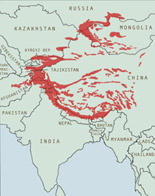 How many snow leopards survive in China?
How many snow leopards survive in China?
According to the latest research (from 2003) there are between 2,000 and 2,500 snow leopards in China. This makes it the largest population in any range country.
However, there’s evidence that these numbers are declining and we need more recent information on the exact number. The IUCN Red List of Threatened Species website says that demand for snow leopard parts like bones and fur in China is fueling poaching and illegal trade in that country as well as in other snow leopard range countries.
Saving snow leopards in China

A snow leopard caught by a trip camera recently in Taxkurgan nature reserve, Xinjiang. Photo Xinjiang Snow Leopard Project.
The Xinjiang Snow Leopard Project (XSLP) is an initiative started by the Beijing Forestry University and the Wildlife Conservation Research Unit (WildCRU) at Oxford University.
The team is working closely with the Xinjiang Government and local communities to research what’s happening with snow leopards and their prey in the Taxkurgan Nature Reserve of West Xinjiang.
Xinjiang is an autonomous region (with its own local government) of China. It is a huge, sparsely populated area, of over 1.6 million square kilomteres (about one sixth of the China’s territory) and shares a border with the Tibet Autonomous Region. The last published information about snow leopard numbers in this area is from the 1980s where George Schaller estimated in one of the local communities that there were between 50 and 75 snow leopards.

Remote Tibetan plateau. Snow leopard habitat. Photo by Sibylle Noras.
This project is really important to see what has happened to the snow leopards here in the last 20 odd years. The team knew from sightings by local herders that snow leopards were still in the area and the recent camera shot of a cat confirmed that. The continuing 2009 work will help to establish numbers and impacts on local herder communities.
The team is made up of staff from Beijing including Shi Kun, Director of the Institute of Wildlife Conservation & Management at Beijing Forestry University as well as field biologists from Xinjiang and a senior postdoctoral researcher at the University of Oxford’s Wildlife Conservation Research Unit, Dr Philip Riordan. The team is keeping a blog of the project.
Poaching of snow leopards still occurs for use of parts in traditional chinese medicines. But in 2010 two herdsmen were sentenced to 10 years imprisonment for killing a snow leopard in this region. It is good to see that laws are being upheld and perhaps the cat will have a future in this region.
Qinghai Province
Tibetan herders in China’s western Qinghai province now actively protect snow leopards in the high grasslands and mountains with help from Plateau Perspectives and Sanjiangyan National Natural Reserve, the largest nature reserve in China. Through the use of camera trap photographs of snow leopards the researchers and local people are able to understand movement and behaviour of cats.
Around 60% of snow leopard habitat is in China, most of it on the Tibetan Plateau. Conservation efforts by the local communities include village people serving as park wardens and environmental advocates. For over ten years some villagers have also been involved in wildlife monitoring by searching and documenting snow leopard sightings, scrapes and scat etc. The area holds other wildlife including blue sheep, wild ass and wild yak, Tibetan antelope, the rare black-necked crane and saker falcon.
WWF Snow leopard conservation

A nomad tending her livestock of cattle and yak on the Tibetan plateau. Photo by Sibylle Noras.
WWF China began a snow leopard conservation project on the Tibetan Plateau in 2006, with a ground- breaking human-wildlife conflict survey conducted in the southern Chang Tang region of Tibet. This survey revealed an extremely high rate of conflict between livestock herders and snow leopards.
The survey was followed by a campaign to diseminate conservation education information showing herdsmen how they can reduce and prevent loss of livestock to snow leopards, such as by avoiding herding in snow leopard habitat, putting roofs on their livestock corrals, and guarding their sheep better. Read more about snow leopards in China here.



